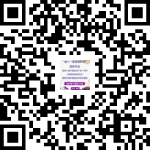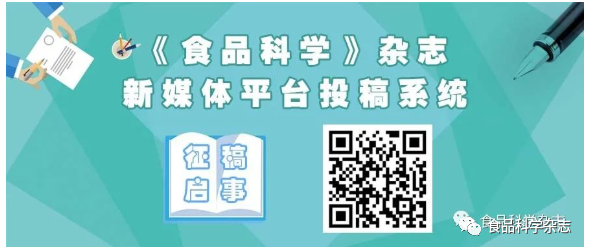

Woodified chicken breast is a type of meat characterized by high hardness and distinct white ridge-like protrusions at the tail. Compared to normal chicken breast, woodified chicken exhibits higher juice exudation rates and poorer external appearance. These issues lead to low consumer satisfaction and purchasing intent when woodified chicken is sold whole. Soy protein isolate (SPI) has long been used in meat product processing to improve product quality and enhance water retention characteristics.
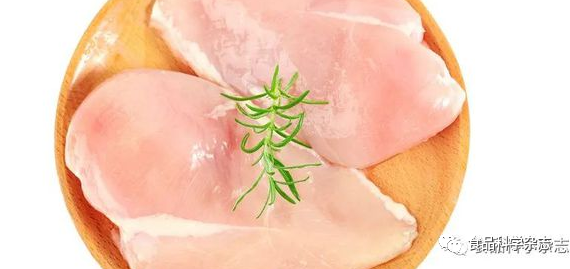
Professors Zhao Zerun, Xing Tong, and Zhao Xue from the Key Laboratory of Meat Processing and Quality Control at Nanjing Agricultural University, Jiangsu Province, conducted research by adding 0% to 2% SPI to low-salt and normal salt (1%, 2%) woodified chicken meat paste. Using normal meat as a control, they measured the texture characteristics, cooking loss, moisture distribution, color characteristics, secondary structure, and other physicochemical properties and processing characteristics of the meat paste gel, and performed correlation analysis on various factors. This study clarifies the improvement effects of different SPI addition levels on low-salt woodified chicken gel products, providing a theoretical basis for improving the quality of deep-processed woodified chicken products and offering new ideas for the application of such heterogeneous meat in low-salt meat products.

1. Effect of SPI Addition on Texture Characteristics of Low-Salt Woodified Chicken
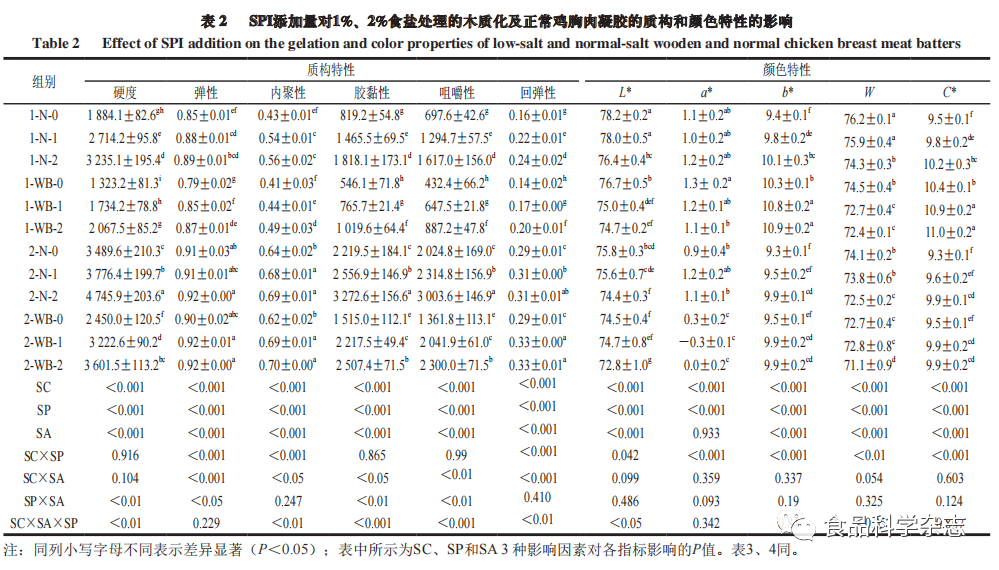
As shown in Table 2, when the same amounts of NaCl and SPI are added, woodified meat exhibits significantly lower hardness compared to normal meat (P<0.05), indicating that under the same formulation, the processing quality of woodified meat is poorer and needs further improvement. As the amounts of salt and SPI increase, the texture indicators of both normal and woodified meat significantly increase (P<0.05). Notably, there are no significant differences in hardness and elasticity between the 2-WB-2 group and the 2-N-0 group (P>0.05), suggesting that the addition of SPI can enable woodified meat to exhibit texture quality similar to that of normal meat. The texture indicators of the 1-WB-1 and 1-N-0 groups show no significant differences (P>0.05), indicating that in a low-salt environment, adding only 1% SPI allows woodified meat to demonstrate similar gel characteristics to normal meat.

2. Effect of SPI Addition on Color Characteristics of Low-Salt Woodified Chicken
As shown in Table 2, with increasing salt addition, the values of L* and W in both normal and woodified meat significantly decrease (P<0.05), while C* significantly reduces (P<0.05). As the SPI addition increases, the values of L* in normal and woodified meat significantly decrease (P<0.05), while b* significantly increases (P<0.05), and a* shows no significant change. Multifactor ANOVA results indicate that SC and SP have a highly significant effect on color (P<0.001). SA has a highly significant effect on all other color indicators except for a* (P=0.933). The interaction of SC×SP significantly affects C*, a*, and b*, while the interaction of SC×SA×SP reaches a significant level for L* and W (P<0.05).

3. Effect of SPI Addition on Cooking Loss of Low-Salt Woodified Chicken

As shown in Table 3, under the same salt and SPI addition levels, the cooking loss rate of woodified meat gel is significantly higher than that of normal meat gel (P<0.05), indicating poorer water retention. Increasing both salt and SPI addition levels can significantly reduce the cooking loss rate (P<0.05). Moreover, there are no significant differences in cooking loss between the 2-N-2 group and the 2-WB-2 group (P>0.05). Multifactor ANOVA shows that the influence of the three main factors on cooking loss is highly significant (P<0.001). Among the two-factor interactions, all except for SP×SA did not reach significance (P=0.35), while the others achieved high significance (P<0.001).

4. Effect of SPI Addition on Moisture Distribution of Low-Salt Woodified Chicken
As shown in Table 3, SP has a significant effect on the moisture distribution of the meat paste system, while SA has no significant effect on P21 and P22, indicating that the type of meat has a greater impact on moisture distribution than the SPI addition level. The 1-WB-1 group shows a significant increase in T22 compared to the 1-N-1 group (P<0.05), indicating that under low-salt conditions, the addition of 1% SPI results in weaker binding of water in woodified chicken meat paste. For the gels after cooking, after adding 2% salt, there are no significant differences in P21, P22, and P23 between the 2-N-0 and 2-WB-0 groups, but P22 in the 2-N-0 group is significantly lower than in the 2-WB-0 group (P<0.05), indicating that the non-flowing water in normal meat gel is more tightly bound within the gel network. As the salt addition increases, the values of T22 and P22 in normal and woodified meat gels significantly increase, while P23 significantly decreases (P<0.05); as the SPI addition increases, the values of T22, T23 in normal and woodified meat gels significantly decrease (P<0.05), while the changes in P21, P22, and P23 are not significant (P>0.05).
In summary, the addition of SPI may fill the voids in the gel network of low-salt woodified meat, controlling the non-flowing water, thus enhancing water retention capacity. Overall, SC and SP have a highly significant impact on P22 and P23 (P<0.001). SP significantly affects P21, while the interaction of SC×SP has a highly significant effect on P22 and P23 (P<0.001), and SC×SA has a highly significant effect on P21. The three-factor interaction has no significant effect on gel moisture distribution.

5. Effect of SPI Addition on the Secondary Structure of Low-Salt Woodified Chicken
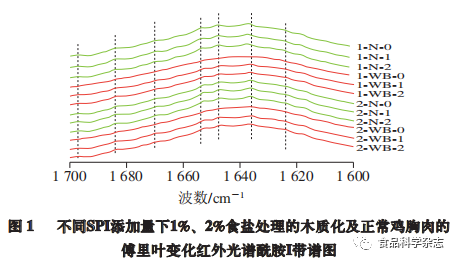
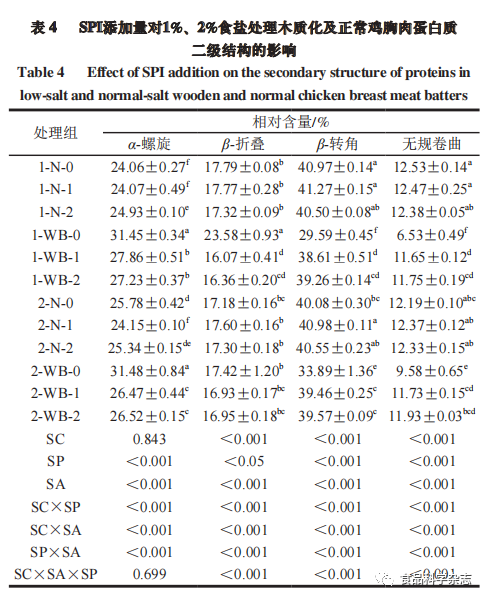
As shown in Figure 1 and Table 4, with increasing salt addition, the relative content changes of the α-helix, β-fold, β-turn, and random coil structures in normal meat are not significant (P>0.05); however, the relative content of α-helix in woodified meat decreases (P<0.05), while the relative content of β-turn and random coil structures increases, indicating a decrease in the orderliness of protein molecules. When the salt addition is 1%, increasing SPI addition does not significantly change the relative content of each secondary structure in normal meat; at a salt addition of 2%, the relative content of α-helix in normal meat first decreases and then increases, while the relative content of β-fold, β-turn, and random coil structures first increases and then decreases. Under different salt addition levels, the relative content of α-helix and β-fold structures in woodified meat shows an increasing trend, while the relative content of β-turn and random coil structures shows a decreasing trend.

6. Correlation Analysis

Conclusion
This study analyzes the texture characteristics, color characteristics, cooking loss, moisture distribution, and protein structure of woodified and normal chicken breast with the addition of 0% to 2% SPI and 1% or 2% NaCl, demonstrating that SPI addition can improve the quality characteristics of woodified chicken breast, reducing the losses associated with woodified chicken in deep processing. Under the condition of 2% salt addition, the water retention and texture characteristics of woodified meat with 1% or 2% SPI addition do not significantly differ from those of the normal meat control group. In summary, the addition of SPI under low-salt conditions affects the changes in the secondary structure of proteins in woodified meat during processing, with organized α-helix and β-fold structures transitioning to relatively disordered β-turn and random coil structures, indicating that increased unfolding may enhance interactions between proteins, leading to more non-flowing water being retained in the gel network, thereby benefiting the water retention and texture quality of the gel. The results of this study provide a reference for improving the quality of woodified chicken breast and a theoretical basis for enhancing the value of gel-type meat products.
This article “The Impact of Soy Protein Isolate Addition on the Gel Characteristics of Low-Salt Woodified Chicken” is sourced from “Food Science”, Volume 43, Issue 6, Pages 49-56, 2022, by authors Zhao Zerun, Xing Tong, Zhao Xue, and Xu Xinglian. DOI:10.7506/spkx1002-6630-20210417-242. Click below to read the original text for more information about the article.
Recent Research Hotspots

